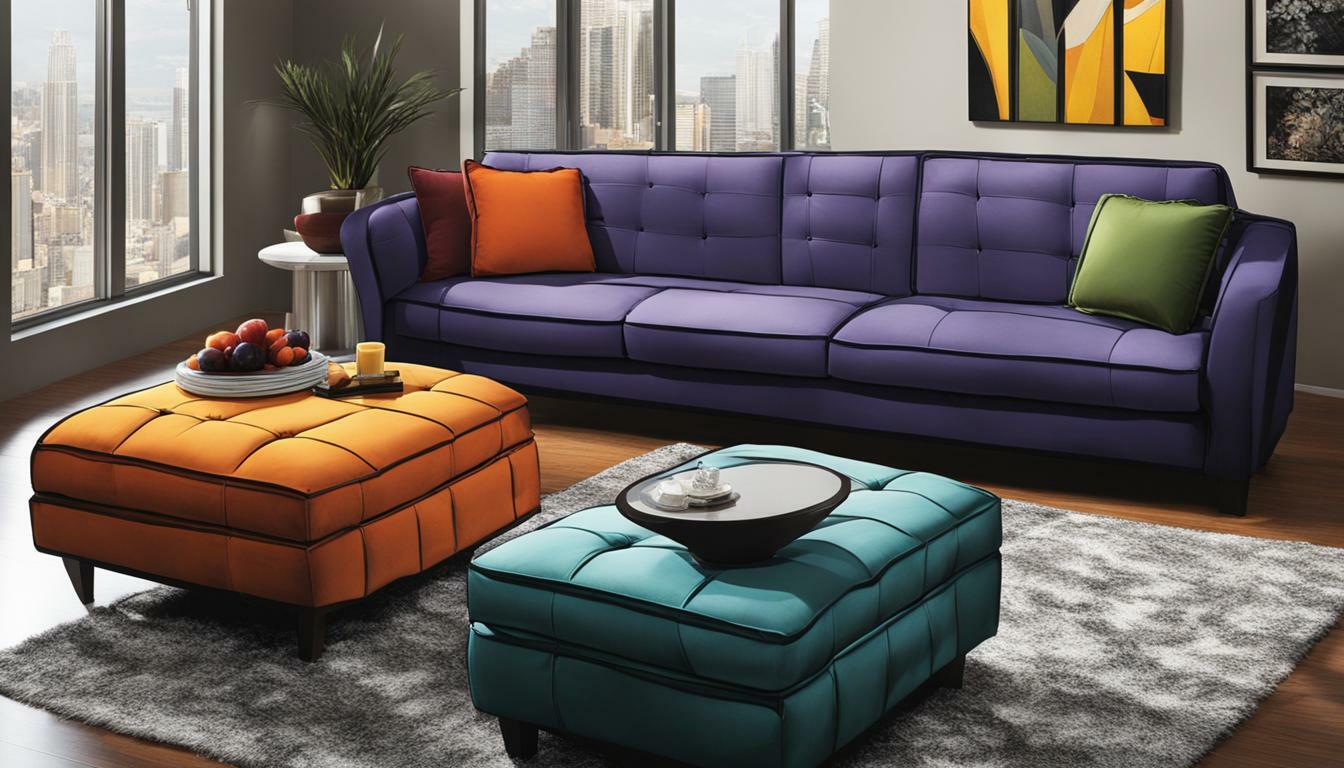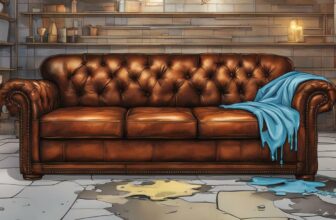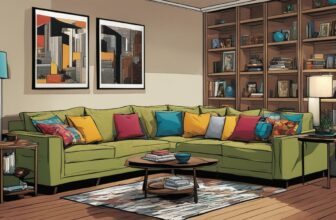
I often come across people using the terms sofa and couch interchangeably. However, have you ever wondered if there is a difference between these two furniture pieces? In this article, we will explore the fundamental characteristics that distinguish a sofa from a couch. We will delve into their definitions, history, design, and usage, to help you understand the subtle yet significant variations between these two furniture items.
Key Takeaways
- There is a difference between a sofa and a couch.
- The terms have distinct origins and cultural backgrounds.
- Design, materials, construction, and usage can all influence the distinction between a sofa and a couch.
Defining a Sofa and a Couch
Before we dive into the differences between a sofa and a couch, let’s first establish what these two terms have in common. Both are types of seating furniture designed for relaxation and comfort.
In fact, some people use the terms interchangeably, considering them to be essentially the same thing. However, there are certain features that distinguish a sofa from a couch.
Similarities Between a Sofa and a Couch
Both sofas and couches often have a frame made of wood or metal, with padding and upholstery covering the structure. They come in various shapes and sizes, from two-seaters to sectionals, and can be upholstered in a variety of materials, from leather to fabric. Both are intended to provide a comfortable place to sit and relax, whether alone or with others.
Distinguishing a Sofa from a Couch
While there are similarities between sofas and couches, there are also key differences. One of the main distinctions is their level of formality. Typically, a sofa is considered to be more formal than a couch, reflecting its origins as a piece of furniture reserved for more elegant or high-end settings. A couch, on the other hand, is typically seen as more casual and comfortable, often associated with lounging and relaxation.
Another difference lies in their design features. Sofas typically have higher backs and armrests, as well as deeper seats, giving them a more upright and formal appearance. Couches, on the other hand, often have lower backs and armrests, with shallower seats, making them more conducive to lounging and relaxation.
The Origins of Sofas and Couches
Many people use the terms “sofa” and “couch” interchangeably, but they do have distinct origins and connotations. The word “sofa” comes from the Arabic word “suffah,” which refers to a raised, carpeted platform used for seating. The term was later adopted in Europe to describe a similar type of seating furniture used in the Middle Ages.
In contrast, the word “couch” has French origins, derived from the Old French word “couche” meaning “bed” or “resting place.” Early couches were designed to serve as both seating and sleeping furniture, often featuring a pull-out or convertible bed mechanism.
Today, the terms “sofa” and “couch” are used relatively interchangeably in modern English. However, some people still make a distinction between the two based on their historical roots and cultural context. In general, “sofa” may be considered more formal and elegant, while “couch” is seen as more casual and comfortable.
As the French philosopher Voltaire once said, “A comfortable old age is the reward of a well-spent youth. Instead of its bringing sad and melancholy prospects of decay, it would give us hopes of eternal youth in a better world.”
In any case, understanding the origins of these terms can help clarify their differences and contextualize their use in furniture discourse.
Design and Functionality
When it comes to design and functionality, the differences between a sofa and a couch can be subtle, yet meaningful.
Size and Shape: Sofas tend to be larger and more formal in design, often featuring straight lines and a fixed back. Couches, on the other hand, are typically smaller and more casual in design, with a curved or sloping back.
Armrests: Sofas often have higher and more structured armrests, while couches may have lower or no armrests, promoting a more laid-back seating experience.
Backrests: While both sofas and couches have a backrest, sofas often have a taller and more upright backrest, providing more support for sitting up straight. Couches may have a shorter backrest or a more angled one, encouraging a more relaxed lounging posture.
Seating Comfort: Sofas tend to prioritize formal seating comfort, often featuring firm cushions and a structured, upright seating position. Couches, on the other hand, prioritize casual comfort, with softer cushions and a more relaxed seating position.
Materials and Construction
The materials and construction methods used in sofas and couches can impact both their overall quality and their aesthetic appeal.
Fabric: Both sofas and couches can be upholstered in a variety of fabrics, from leather to cotton to synthetic blends. However, sofas may be more likely to feature premium materials like top-grain leather or designer fabrics, while couches may be more budget-friendly.
Frame: The frame of a sofa or couch can be made of wood, metal, or other materials. However, sofas may be constructed with sturdier and more durable frames, as they are typically expected to last longer and withstand more wear and tear.
Cushions: The cushions of a sofa or couch can also vary, with sofas more likely to feature structured and supportive cushions, and couches more likely to have softer and more plush cushions.
The Usage and Placement of Sofas and Couches: Understanding the Difference
When it comes to determining the difference between a sofa and a couch, one must consider how and where these furniture pieces are commonly used. While both can be found in a variety of settings, there are specific usage and placement differences that set them apart.
Traditionally, sofas have been associated with more formal settings, such as living rooms or sitting rooms. Sofas tend to be larger in size and offer more seating options, often with a higher backrest and armrests. They are designed for hosting guests, entertaining, and socializing.
Couches, on the other hand, are often associated with more casual settings, such as family rooms or dens. They tend to be smaller in size and offer a more laid-back and relaxed seating option. Couches may have lower backs or no armrests, allowing for more comfortable lounging and relaxation.
In terms of placement, sofas are often positioned facing a central focal point, such as a fireplace or a television. They may be arranged in a formal pattern, such as an L-shape or U-shape, to encourage conversation and socializing.
Couches, on the other hand, are often positioned in a more casual and relaxed manner. They may be placed against a wall or in a corner, with additional seating options, such as chairs or beanbags, added to create a comfortable and inviting atmosphere.
Overall, while both sofas and couches serve the same basic function of providing seating, their usage and placement can vary significantly depending on the intended setting and desired atmosphere. By understanding these differences, you can choose the right furniture piece to suit your needs and create the perfect ambiance in your living space.
Materials and Construction
When it comes to differentiating between a sofa and a couch, the materials used in their construction can play a significant role. While both pieces of furniture can be upholstered in a wide range of fabrics, leather, or vinyl, the quality and durability of these materials can vary. Sofas, for example, are typically made with higher-quality materials, such as top-grain leather, hardwood frames, and high-density foam cushions. This often makes them more durable and long-lasting than couches, which may be constructed using lower-quality materials.
Another factor to consider is the construction method used for each piece. Sofas are often built with more attention to detail, featuring hand-tied springs, reinforced frames, and precise dimensions. Couches, on the other hand, may be mass-produced with lower levels of detail and customization. As a result, sofas may be more expensive than couches, but they often offer greater value and longevity.
Overall, while both sofas and couches can be comfortable and aesthetically pleasing, the materials and construction techniques used in their production can impact their quality and durability. When deciding between a sofa or couch, it’s important to consider the materials and construction in addition to personal preferences and budget.
Price Range and Market Perception
Another factor that can help distinguish between a sofa and a couch is their price range and market perception. Generally, sofas tend to be perceived as more upscale and expensive compared to couches. This is because sofas are often associated with formal settings, such as living rooms and upscale hotels, while couches are seen as more casual and suitable for family rooms or dens.
As a result, the price range for sofas can vary greatly, with upscale, designer sofas reaching several thousand dollars, while affordable options can be found for a few hundred dollars. Couches, on the other hand, tend to be less expensive, with entry-level options starting at a few hundred dollars and higher-end versions reaching up to a few thousand dollars.
While price and market perception can vary depending on the brand and location, it’s worth considering these factors when deciding between a sofa and a couch. Ultimately, the decision should be based on personal style, comfort, and intended usage.
Trends and Contemporary Usage
As we’ve seen, the distinction between a sofa and a couch can be subtle but significant. However, in contemporary usage, the terms are often used interchangeably. This can be attributed to the evolution of furniture design and the blending of traditional styles.
One trend that has emerged is the use of the term “sofa” for larger, more formal pieces, while “couch” is used for more casual or smaller furniture. However, this is not always consistent, and many modern furniture designers use the terms interchangeably.
Another trend is the increasing emphasis on functionality and versatility. Sofas and couches are designed to be adaptable to different spaces and needs. For example, some modern designs feature modular components that can be arranged in different configurations to suit different room layouts.
The use of eco-friendly materials and sustainable production methods is also becoming more prevalent in modern furniture design. This trend is reflected in the growing popularity of organic and natural fiber upholstery materials, as well as the use of recycled and reclaimed wood for frames and legs.
Overall, when comparing sofas and couches in contemporary usage, it’s essential to consider individual preferences, design styles, and cultural context. What matters most is that the furniture piece aligns with the user’s needs and personal taste – whether it’s called a sofa or a couch.
Conclusion
After exploring the similarities and differences between sofas and couches, it is clear that there are subtle distinctions between the two. While they share a common function as seating furniture, their design, construction, and usage can vary.
From the historical origins of these terms to the materials and construction methods used, each aspect contributes to the difference between a sofa and a couch. Additionally, price range and market perception can also play a role in consumer choices and perceptions of these furniture pieces.
Individual Preferences and Cultural Context
Ultimately, individual preferences and cultural context may influence how we perceive and use sofas and couches. Some may consider the term “sofa” to imply a certain level of sophistication, while others may use “couch” as a more casual term. Likewise, the intended use and placement of these furniture pieces can vary depending on cultural norms and personal preferences.
Overall, the distinction between a sofa and a couch may seem small, but understanding the subtle differences can make all the difference when choosing the right furniture piece for your home or office.
FAQ
Q: What is the difference between a sofa and a couch?
A: The main difference between a sofa and a couch is the name itself. Historically, a sofa referred to a more formal piece of furniture, often associated with wealth and elegance. On the other hand, a couch was seen as a more casual and comfortable option. However, in modern usage, the terms are often used interchangeably, and the distinction between the two has become less defined.
Q: How can I distinguish between a sofa and a couch?
A: To distinguish between a sofa and a couch, you can consider factors such as the formality of the piece, its design and construction, and its intended usage. Sofas tend to have more structured and formal designs, with features like high backs and armrests. In contrast, couches often have a more relaxed and casual appearance, with lower backs and a focus on comfort.
Q: Can I use the terms sofa and couch interchangeably?
A: Yes, in modern usage, the terms sofa and couch are often used interchangeably. The distinction between the two has become less significant, and it is common for people to refer to both types of furniture as either a sofa or a couch.
Q: Which is more comfortable, a sofa or a couch?
A: The comfort level of a sofa or a couch can vary depending on the specific piece and the individual’s preferences. Some sofas may offer more structured seating with firmer cushions, while certain couches prioritize softness and plushness. Ultimately, the comfort of a seating piece is subjective and can vary from person to person.
Q: Are there any differences in price range between sofas and couches?
A: The price range for sofas and couches can vary depending on factors such as the brand, materials used, design complexity, and overall quality. While there may be some price variations between specific sofas and couches, it is not necessarily determined by whether it is called a sofa or a couch.





